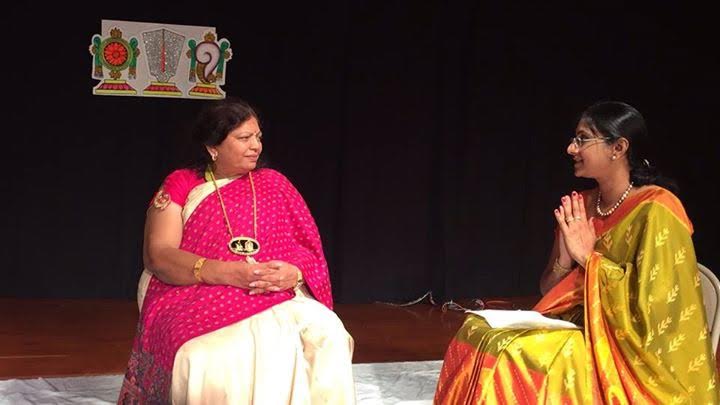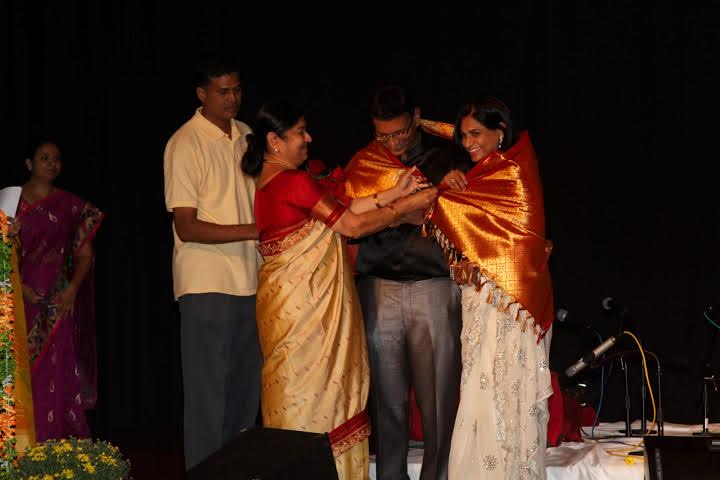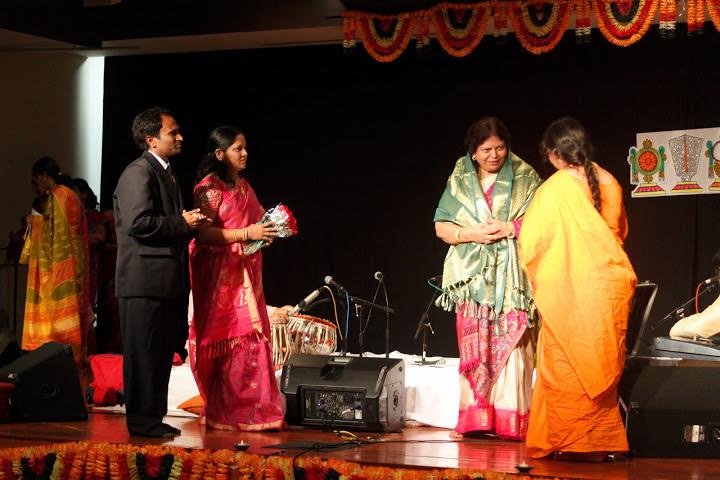Contribute
| In Conversation With Dr. Shobha Raju |
Padmaja Surapaneni:
09/07/2015
(This article is sponsored by Tanna Insurance)
Interview with Padma Shri Dr Shoba Raju Garu (translated from a Telugu interview)
TAGB, recently invited Dr Shobha Raju an renowned musician, devotional singer, writer and composer, known as an exponent ofsankirtana of the gospel of the 15th-century saint-composer, Annamacharya.[1]
Can you please tell us about your childhood?
I was born to Late Smt Rajyalakshmi garu and Late Sri Narayana Raju garu. I was fortunate to have my mother as my first music guru and my father as my spiritual mentor.
When did you start your formal education in music and when did you start singing?
My first performance was at the age of 3 yrs, when I first composed my own song on Lord Krishna in Nepali. I did not have any idea nor did I understand the difference between poetry and literature. It was in my 8th grade that I was introduced to violin gurus Sri Pulliah garu and Sri Subbanna Garu and it was then that I started my formal classical music training. I did my under graduation in Arts with a specialization in Music. I also formally trained under various Gurus who include Sri Sheshagiri Rao garu, Sri Pakala Munirathnam garu, Sri Nedunuri Krishna Murthy and Prof Kalpakam garu
You mentioned you Amma was your first guru, who was the guru who had a biggest influence on you?
Every guru was a great influence on me. However while learning under late Sri Nedunuri Krishna Murthy garu I learnt the finer point on rendering the notes and I understood the Gamakas which are the points of emphasis in ragas in classical music better. My interest and respect for Karnataka music also grew during this period.
After learning Classical music why is that that you only focused exclusively on Sri Annamacharya Kirthanalu?
I received a scholarship from Tirupati Tirumala Devasthanam (TTD) to study and master the Sankeerthanas of Sri Annamacharya. While mastering the Sankeerthanas I understood the inner meaning & depth, thought process, the messages and the poetry of these sankeerthanas. I also understood the selfless devotion of Sri Annamacharya’s life to Lord Venkateshwara swamy.
What are the total number of Sankeerthanas written by Sri Annamacharya? how many of these are available to us? and how many of these did you tune and sing.
The total number of sankeerthanas known to us are 32000, out of these we can only find 15000 sankeerthanas and out of these the total number of Sankeerthanas tuned and rendered by various singers/artists are 3000. The most popular out of these are only 500.
I sang close to 1000 and also personally tuned upto 650 sankeerthanas on my own.
Sri Annamacharya keerthanas are very popular in South India, thanks to your efforts. What steps and efforts are being put to popularize Sri Annamacharya keerthanas in North India?
In 1999 a Hindi CD of Sri Annamacharya keerthanas was produced. It was also formally released by the then minister Mr. Arun Jaitely. Provided the right resources and sponsorships we are more than willing to travel and perform and popularize these keerthanas in North India as well.
You have created the Sri Annamacharya Bhavana Vahini institute, what are its activities?
In 1983, I formed the Sri Annamacharya Bhavana Vahini institute with an aim to eradicate “thought pollution†through divine music. In this institute we train singers on Sankeerthnas. In “Annamayya Sadanam†(in Annamayya puram) we provide opportunities for youth singers to perform. In addition we celebrate the birthdays of Sri Annamayya and his son Pedda Thirumalayya and we also perform the Mahanagara Sankeerthana at Nada Brahmotsavam and Guru Purnima.
We produced various publications on Sri Annamacharya and a TV Serial. A stamp commemorating Sri Annamacharya was also released.
They say Music is helps in healing, can you elaborate?
Listening to music will stimulate portions of the brain and modulates genes that are responsible for brain functions. Meditation helps in relaxation and stress. Music combined with meditation helps in concentration and effects rival antidepressants for depression and anxiety. Music has the power to stimulate the part of the brain that organizes thoughts and movements into action.
Your singing ability would have led you to opportunities to sing in cinema. Why did you not pursue this career?
During my early days of singing, I received accolades from leading classical and playback singers and they encouraged me to be a playback singer in movies, I did incline towards this career and I did have a few offers. However, I had already promised to Lord Venkateshwara swamy that I would dedicate myself to promoting the works of Sri Annamacharya. I have completely immersed myself for 37 years into this service and it is truly a blessing.
I followed you on facebook and one particular post of yours addressed to young Lord Krishna attracted me, is that your own thought or a line from the sankeerthana?
Facebook post translated (at the expense of not being as powerful as the original telugu post): “For how long should I be singing your praises and feed you? When will you feed me with your hand? Before I lose my strength please grow and blossom.â€
Dr Shobha Raju:(very emotional and teary): It is my thought. For over 37 years I have singularly focused and dedicated myself to promoting Sri Annamacharya Keerthanaas, constructing a temple of Lord Venkateshwara. I want to build a “Heaven of Music†via a University dedicated to music of Sri Annamacharya. I do not know how long I can continue with this and hence that post was a request to Krishnayya to fulfill my goals.
In conclusion:
We are blessed that someone dedicated like Padma Shri Dr Shoba Raju is promoting Sri Annamayya’s music and he would be proud with her achievements to-date and goals that she has set herself. We wish her all the very best to achieve her pure and holy goals which she has embarked (1) to complete the unique temple of Lord Venkateshwara (with Sri Annamayya in the same garbham) (2) Build the “Heaven of Music†the music university of Sri Annamacharya and (3) Kumbhabhishekham
Glossary:
- Gamakam: is any graceful turn, curve or cornering touch given to a single note or a group of notes, which adds emphasis to each raga's individuality
- Kumbhabhishekham is a Hindu temple ritual that is believed to homogenize, synergize and unite the mystic powers of the deity. Kumbha means the Head and denotes the Shikhara or Crown of the Temple (usually in the Gopuram) and Abhisekham is ritual bathing.
You may also access this article through our web-site http://www.lokvani.com/



